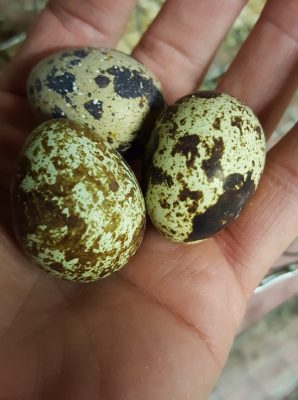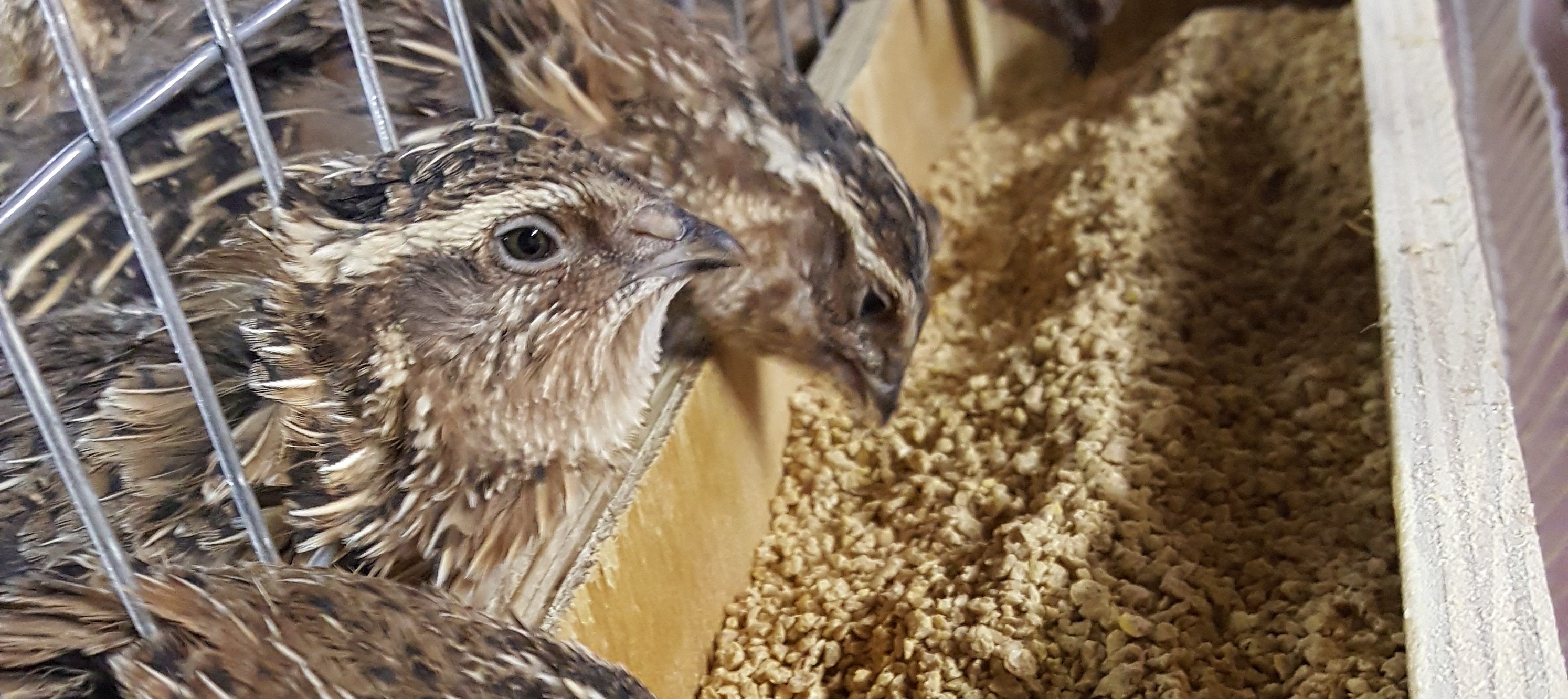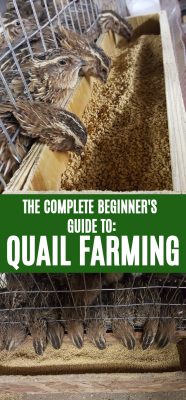While chickens rule the roost for popularity with homesteaders and self-reliance seekers, we take a look at their smaller equivalent, the humble quail, and how easy it is to get started with quail farming so that you can grow your own sustainable food supply of eggs and meat, whether you are in an urban area, the city, or out in the homesteader’s country backyard.
Being able to provide your own food isn’t just a thing for preppers. Self-reliance is becoming more and more popular as people see how easy it is for store shelves to go empty and food supply lines to be cut. Learning new ways to get your own daily food needs is smart consumption and comes with the added benefit of being able to save money, eat healthy homegrown foods, and have your own food supply should something ever go wrong. Quail farming allows you to produce your own highly nutritious eggs, meat and provide great manure for the garden.
Why would you choose quail farming over chicken farming? Easy, they are prolific and may be kept in many places that other poultry cannot. The particular breed of quail that I am writing about is Coturnix Quail. This type of quail had been bred as a food source for some 2,000 years. Not only are they easy to keep, but their eggs and meat are wonderful to eat.
This fairly quiet avian is not only compact and easy to keep but much less noisy than the flock of chickens you are used to. The leader of the pack, the quail rooster, can often go unnoticed in apartments and urban areas which gives you the added benefit over chickens, and neighbors complaining about the crow of a rooster at first daylight.
What are the benefits of quail eggs?
 Coturnix quail eggs are amazing for their small size. Not only are they delicious but they are also healthy, and research has been shown to have various medicinal purposes against a number of health issues. The benefits of quail eggs are almost endless, for instance, according to research they are good for building muscle, immune boosting, bone health, brain productivity and fertility, just to name a few.
Coturnix quail eggs are amazing for their small size. Not only are they delicious but they are also healthy, and research has been shown to have various medicinal purposes against a number of health issues. The benefits of quail eggs are almost endless, for instance, according to research they are good for building muscle, immune boosting, bone health, brain productivity and fertility, just to name a few.
A lot of people ask me how many quail eggs equal a chicken egg. While they are quite different in shape and nutrients they taste very similar. I would say three quail eggs is a good comparison to one chicken egg.
I love eating quail eggs raw, pan-fried, boiled and in the hundreds of recipes that are out there. People that have egg allergies will be glad to know they can safely eat quail eggs all day long. They have also been considered a more nutritious option in comparison to chicken eggs for a number of factors. The table below indicates the nutritious difference between the two.
Quail Eggs vs Chicken Eggs
| NUTRIENT | QUAIL EGGS | CHICKEN EGGS |
|---|---|---|
| Fat % | 10.83 | 11.50 |
| Cholestrol (mg/g yolk) | 16.28 | 17.97 |
| Protein (%) | 13.23 | 12.80 |
| Energy (Caloric/100g) | 155 | 122 |
| Vitamin A (IU/100g) | 2947 | 174 |
| Calcium (mg/100g) | 71.81 | 34.70 |
You could really write books on the medicinal use of quail eggs in Asia. I cannot tell you if any of the medicinal claims are true, but such a tasty egg deserves to be eaten, and if it has some health benefits to go along with it, eating them certainly cannot hurt.
Is there a market for quail eggs?
There are a few different prices depending on what time of year it is and the area you are in, when it comes to selling quail eggs. However, if you are after a rough pricing, which is based on my area and a few other different places, you might consider quail egg sales at around the following prices:
- If you are selling fertile (incubated quail eggs) most farmers fetch 0.70c – $1 for each egg.
- If you are selling normal quail eggs to everyday buyers $4-$5 for a dozen
- There are some ‘fancy’ restaurants that are mad about fresh quail eggs. It’s a niche market but if you can provide a stable supply to them they are willing to pay a fair bit.
The fertility rate of quails is in its prime after about 7 or 8 weeks and that period will start to slow after 9 months. Most quails will average between 200-250 eggs per year so there is a clear profit if you are considering having lots of quails. This can be very time intensive though and can become a full-time job farming quails.
Benefits of Coturnix quail meat

If you think the eggs are impressive, wait until you taste quail. I love quail meat; it all starts with the processing. Processing quail is quick and easy (I can process 30 in 30 minutes by myself.) And there is no need to pluck them unless you really want to, but I have found no benefit to plucking.
If you are working with Coturnix quails, these things have a great turnaround for their growth and can be eaten at 8-9 weeks old when they’re fat. They also only take 15-20 days for the eggs to hatch, so all in total, as soon as an egg is incubated, you’re looking at 11-12 weeks until you can cook and eat your quails or sell them.
These little birds have some really amazing quality in the meat. Other benefits of these quail are found in their vitamins and minerals.
- Vitamin A
- Vitamin B
- Vitamin D
- Vitamin K
- Calcium
- Phosphorus
- Iron
- Zinc
Aside from the vitamin-value they possess, quail is also a great source of fast-growing protein. Some of the health benefits you may find from eating the meat are amazing. Eating quail can actually help your vision return or stay sharp. Some degenerative eye issues are from a lack of proper vitamins and minerals that are found in quail meat.
Some skin issues can also be solved with quail meat. The fatty acids, vitamin E, A and B work to keep our skin healthy and supple. With today’s fast food diets, we are lacking many of those necessary vitamins, so introducing quail can help your health. But our bony structure will also be aided with the phosphorus and calcium.
Our brain, immune system, and respiratory system benefit from quail meat and eggs. Anemia can also be treated by adjusting our weekly diets to incorporate quail. Just a simple little creature that tastes so good deserves a place in any homestead.
As for how much quail meat is suitable, I am a 95kg guy and eat two for dinner, but could fit three.
How to get started with quail farming
So let’s take a look at how easy it is to get started with quail farming. I hope that with these easy lessons and tips for the issues you will come across, you will start your own quail farm and have as much fun as what I have had.
What type of cage should you use for quail farming?

If you are in the country, you might opt to keep quails in an open pen, however, if you want to get into quail breeding in a more space-saving manner, such as an urban area or in your backyard, you can have them grow in a cage.
For Coturnix quail, they are possibly the world’s worst flyers, so they don’t need much headspace to fly around. In fact, they are a danger to themselves and less headspace is actually better for them. If they have a foot or more of height, it is quite possible that they could kill themselves. Quail are naturally spooky and will jump or fly fast enough in a short burst to either break their necks or smash their heads. Some people don’t agree with having short cages, but I have never had a quail killed from crashing against the pen.

My pens are made of wood or wire. They measure 4ft long, 2ft wide and 10ft tall. The floors of the pen are made from 1”x ½” rabbit wire. This is the perfect size to let the “poop” fall through much easier than the ½”x½”. The ½”x½” can end up holding the manure, and it will build up on the quail’s feet, causing disease. No one wants that build up as we want to keep our birds healthy and happy so that they can produce well and stay healthy.
The roof and walls can either be wire or wood. When I use wire, I choose the 1” x 2” wire in 24” length. If you choose to use wood, make it any length you like. These are pictures of both my wire and wood cages.
Quail only need a small amount of space. One square foot can handle four adult quail. That’s the same space that one chicken needs. In a 2’x4’ pen you could have 32 birds. On that measure, they’re a good space saver even though they produce little eggs.
Coturnix quail are so fragile as chicks, but once they reach adulthood they can stay outdoors year-round. Rain and snow won’t faze these little birds. Keep the drafts away by moving their cages to the least windy side of your home with shade.
How many quails should you start with?
How many quails you should start with really depends on what you are after in regards to space and ability to commit the time to actually breeding them. Some quail farmers have 20 or 30 whereas much more commercial entrepreneurs have thousands of quails. If you just want to start small I’d say count your numbers in sets of five hens (1 make: 5 hens). So if you want a flock, choose 10 or 15. From that perspective, you can start to see how much food they take and get a feel for what farming them is all about. Once you are happy to expand, you can introduce males into that group and crack on into the fun game of breeding.
If you are considering breeding quails, here’s a good formula to get you started:
- Start with 100 Coturnix quails.
- Keep 25 hens and 5 males, and eat the 70 left over (keep them in the freezer) – this should make for a few meals on 3 quail per meal.
- With those 25 hens, you can keep hatching from 25 eggs just after one day’s worth of laying.
- After a week you would have 175 new incubated eggs.
- Expand farm.
When you are breeding quail, female quail (hen) won’t need a male (cock) to lay eggs. They will need a male in order to have fertile eggs. If you only need eggs for eating or selling, then don’t waste the feed on keeping males. To be more sustainable, you can hatch out your own eggs. The proper ratio is one male for every 4-5 females. Less than this and you may have fertility issues. More males than this ratio can lead to fighting. Quail layers only lay well for about eight months, so I would restock in that time period.
How to incubate quail eggs

Coturnix Quail are an excellent livestock and easy to reproduce. Most incubators, even the small Styrofoam incubators, hatch out quail eggs easily. You really don’t even need an automatic egg turner. Just turn them 3 times a day with a careful roll of your hand. The eggs only get turned for the first 14 days. They should not be turned after this because the chick needs to be still to crack its shell open.
The temperature is the most important detail to pay attention to when incubating quail eggs. Strive for 99.5 Fahrenheit (37.5 Degrees Celsius). Any fluctuations are negligible for the home hatchery. You can expect between a 50% and 75% hatch rate.
Humidity is also really flexible. Some people add water, and some hatch out dry. I add a little water to the bottom of my hatcher on day one and then let it dry up on its own. I think too high of a humidity is a bigger mistake than keeping things dry.
Your Coturnix Quail will hatch in 18-19 days. What an exciting time to wait until the first crack. When I first started quail farming I would check the eggs every day in the leadup to see the first crack and the first egg hatch.
You should leave your hatchlings in the incubator for 24 hours without opening the incubator. You don’t want to let the humidity escape. That little bit of humidity will make it easier for the little chicks to climb out of the shell and take their first steps.
Don’t worry about feeding or watering in this 24-hour period. They will hatch with full bellies.
Using a brooder for quail chicks
After your Coturnix Quail have hatched, they need to go into the brooder. The brooder is necessary and should be draft free and 95 degrees Fahrenheit (35 Degrees Celcius) for the first week. Drop the temperature by 5 degrees every week until they get to 70 degrees (21). After this, they are ready to go where you need them to.
Catching and using quail manure in the garden
Manure is easily handled by falling through the quail farm’s wire floor and being caught by some sort of structure or material. I prefer to put a piece of plywood underneath the pens and line it with newspaper or a roll of brown paper cut to size. Some others make sheet metal pans to catch the manure. You won’t have to worry about urine like you do with rabbits, so no edges are needed on the catch pan.
For the most part, what goes in your quail will come out the other end. This is one of the biggest reasons that I feel they are the perfect homestead livestock. Quail manure is high in nitrogen, and they produce a huge amount of manure. I feed my quail about 150 pounds of feed a week, and I nearly get all that back.
So not only do I get to consume the meat and eggs from the feed, but I also get all the fertilizer I need with some to sell.
What to feed quails

When you are quail farming you need to remember that quail have some needs when it comes to what food you should give them. Quail need high protein so a feed with 22% or higher is the best choice. This can sometimes be hard to find locally. I can only find 24% Dumor from Tractor Supply, but it is consistent in quality. Quail cannot be fed any medicated feed. They just can’t handle it regularly. For short periods, when your quail are sick, a medicated feed may helpful, but absolutely don’t try and give it to them on a regular basis. I don’t use medicated feed at all; I rather cull any quail that are sick and keep the stronger ones otherwise disease can spread.
Some other feed options to are to feed your quails:
- Mealworms
- Soldier flies
- Worms
- Boiled eggs
- Sprouted wheatgrass – which is a great option
- Corn, wheat, barley, oats
- Blackberries, Blueberries, raspberries, strawberries
- Seed from giant ragweed, western ragweed, soybean, sorghum, sunflowers
- Other plants like beans and cowpeas are also great quail feed
Don’t sit back, start quail farming!
Do you think you are up to the challenge of having your first few quails? Once you have mastered a few, why not introduce a male into it and really step up the quail farming game? I find it fun and rewarding to farm quail and they’re very easy to keep. What’s better is they take less space than chickens, but provide very nutrient eggs, meat and high-quality manure for the garden. How easy is that? What’s more is that we have found things such as eggs and food are an in-demand item when the SHTF, so when the time comes such as an economic collapse and you have a quail farm, you are in pretty good stead to have food and replenishing tradeable goods.
Coturnix quail, especially, are a great species for any homestead at any scale, whether you live in an urban area, or in the country. Even people that live in the city can build a rack or keep a birdcage to produce eggs and meat and breed quail. Balconies, rooftops, garages and even the laundry room are all options. Check with local Coturnix breeders for stock, state and local regulations.
It’s easy, resourceful and a very sustainable method of easy meat, egg and manure production, so give it a go, and let us know what you think in the comment section below.


Off grid always intrigues me. ?
How do these quail fare in a Northern climate, such as Western Wisconsin?
Is the feed you give to your quail the same as the rumor chicken meal crumble from tractor supply? Or is it the same as the chick feed?
You mention that you dont pluck? Please explain.
You skin them